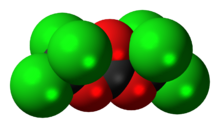Chemistry:Triphosgene

| |

| |
| Names | |
|---|---|
| Preferred IUPAC name
Bis(trichloromethyl) carbonate | |
| Other names
BTC
| |
| Identifiers | |
3D model (JSmol)
|
|
| ChemSpider | |
PubChem CID
|
|
| UNII | |
| |
| |
| Properties | |
| C3Cl6O3 | |
| Molar mass | 296.748 g/mol |
| Appearance | white solid |
| Density | 1.780 g/cm3 |
| Melting point | 80 °C (176 °F; 353 K) |
| Boiling point | 206 °C (403 °F; 479 K) |
| Reacts | |
| Solubility | *soluble in dichloromethane[1] |
| Hazards | |
| Safety data sheet | SDS Triphosgene |
| GHS pictograms |   [4] [4]
|
| GHS Signal word | Danger |
| H314, H330[4] | |
| P260, P280, P284, P305+351+338, P310[4] | |
Except where otherwise noted, data are given for materials in their standard state (at 25 °C [77 °F], 100 kPa). | |
| Infobox references | |
Triphosgene (bis(trichloromethyl) carbonate (BTC) is a chemical compound with the formula OC(OCCl3)2. It is used as a solid substitute for phosgene, which is a gas and diphosgene, which is a liquid.[5][6] Triphosgene is stable up to 200 °C.[7] Triphosgene is used in a variety of halogenation reactions.[8]
Preparation
This compound is commercially available. It is prepared by exhaustive free radical chlorination of dimethyl carbonate:[6]
- CH3OCO2CH3 + 6 Cl2 → CCl3OCO2CCl3 + 6 HCl
Triphosgene can be easily recrystallized from hot hexanes.
Uses
Triphosgene is used as a reagent in organic synthesis as a source of CO2+. It behaves like phosgene, to which it cracks thermally:
- OC(OCCl
3)
2 ⇌ 3 OCCl
2
Alcohols are converted to carbonates. Primary and secondary amines are converted to ureas and isocyanates.[6][7][9][10]
Triphosgene has been used to synthesize chlorides.[8] Some Alkyl chlorides are prepared by treating alcohols with a mixture of triphosgene and pyridine. Alkyl dichlorides and trichlorides can similarly be synthesized using triphosgene. Vinyl chlorides are synthesized from ketones using triphosgene and DMF to form a Vilsmeier reagent, followed by a ring opening by chloride ions. Aryl chlorides can also be produced using a Vilsmeier reagent from triphosgene and DMF.
Safety
Triphosgene's low vapor pressure makes it possible for it to reach concentrations that are considered toxicologically unsafe.[11] While several properties of triphosgene are not yet readily available, it is known that it is very toxic if inhaled. A toxic gas is emitted if it comes in contact with water.[12] There is a lack of information and variability regarding the proper handling of triphosgene. It is assumed to have the same risks as phosgene.[13][14]
See also
References
- ↑ "Biodegradable coumaric acid-based poly(anhydride-ester) synthesis and subsequent controlled release". Macromolecular Rapid Communications 34 (15): 1231–1236. August 2013. doi:10.1002/marc.201300323. PMID 23836606.
- ↑ "Immobilization and chiral recognition of 3,5-dimethylphenylcarbamates of cellulose and amylose bearing 4-(trimethoxysilyl)phenylcarbamate groups". Chirality 22 (1): 165–172. January 2010. doi:10.1002/chir.20722. PMID 19455617.
- ↑ "New Method of Synthesizing N-Alkoxycarbonyl-N-arylamide with Triphosgene". Synthetic Communications 36 (18): 2661–2666. September 2006. doi:10.1080/00397910600764675.
- ↑ 4.0 4.1 4.2 Sigma-Aldrich Co., Triphosgene.
- ↑ Roestamadji, Juliatiek; Mobashery, Shahriar (2001). "Bis(trichloromethyl) Carbonate". Encyclopedia of Reagents for Organic Synthesis. doi:10.1002/047084289X.rb200. ISBN 0471936235.
- ↑ 6.0 6.1 6.2 Heiner Eckert; Barbara Forster (1987). "Triphosgene, a Crystalline Phosgene Substitute". Angew. Chem. Int. Ed. Engl. 26 (9): 894–895. doi:10.1002/anie.198708941.
- ↑ 7.0 7.1 "(4R,5S)-4,5-Diphenyl-3-Vinyl-2-Oxazolidinone". Organic Syntheses 75: 45. 1998. doi:10.15227/orgsyn.075.0045.
- ↑ 8.0 8.1 "A decade review of triphosgene and its applications in organic reactions". Tetrahedron 76 (47): 131553. November 2020. doi:10.1016/j.tet.2020.131553. PMID 33883783.
- ↑ "Synthesis of Amino Acid Ester Isocyanates: Methyl (S)-2-Isocyanato-3-Phenylpropanoate". Organic Syntheses 78: 220. 2002. doi:10.15227/orgsyn.078.0220.
- ↑ "Pd(0)-Catalyzed Diamination of Trans-1-Phenyl-1,3-Butadiene with Di-tert-Butyldiaziridinone as Nitrogen Source". Organic Syntheses 86: 315. 2009. doi:10.15227/orgsyn.086.0315.
- ↑ "Bis(trichloromethyl)carbonate (BTC, Triphosgene): A Safer Alternative to Phosgene?" (in en). Organic Process Research & Development 21 (9): 1439–1446. 2017-09-15. doi:10.1021/acs.oprd.7b00220.
- ↑ "Material Safety Data Sheet: Triphosgene". 2009. https://ehslegacy.unr.edu/msdsfiles/26588.pdf.
- ↑ "Safe handling of diphosgene, triphosgene.". Chemical & Engineering News 71 (6): 4. February 1993. http://pubsapp.acs.org/cen/safety/19930208.html?.
- ↑ "Phosgene inhalation toxicity: Update on mechanisms and mechanism-based treatment strategies". Toxicology 450: 152682. February 2021. doi:10.1016/j.tox.2021.152682. PMID 33484734.
External links
 |

